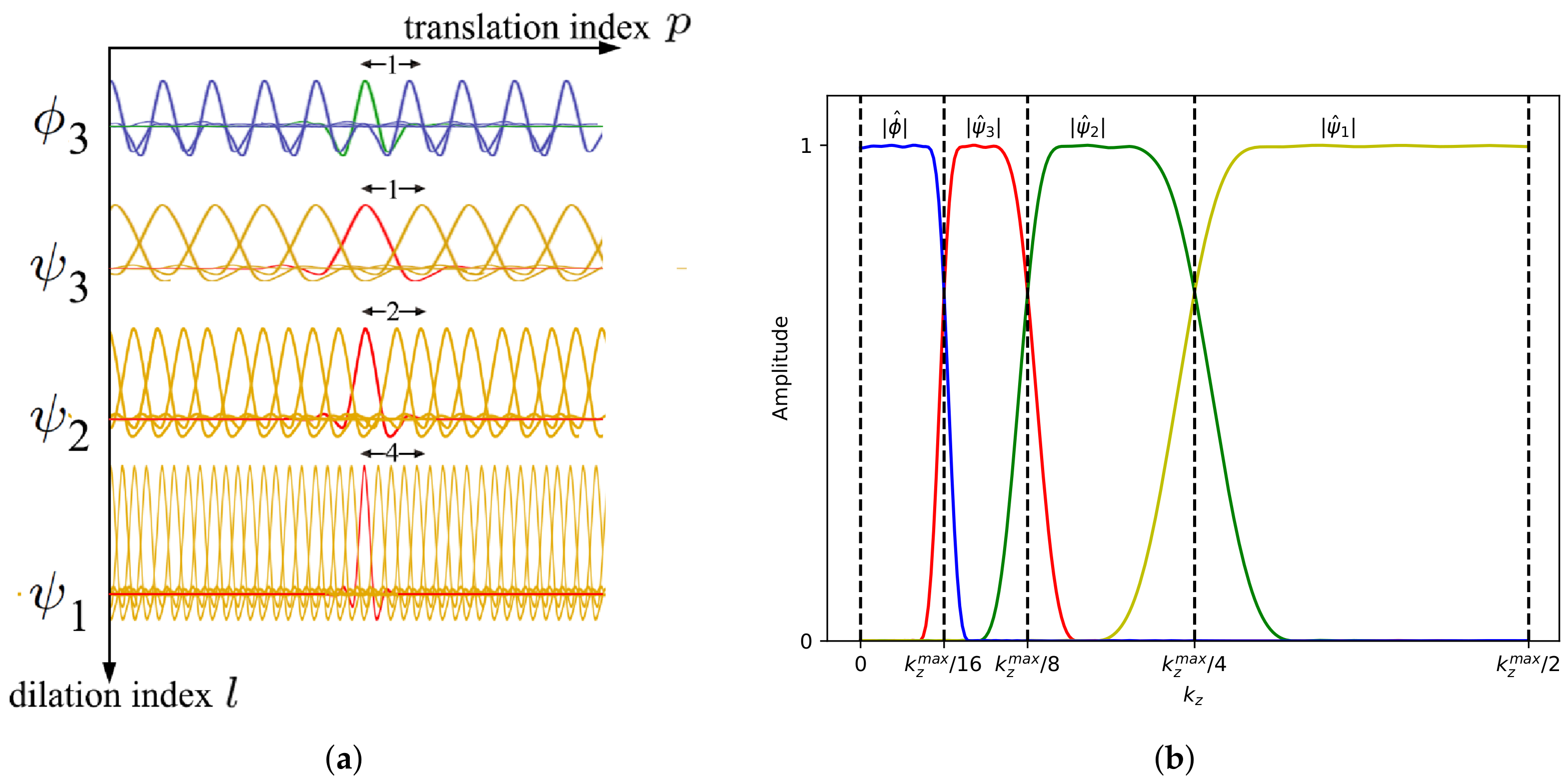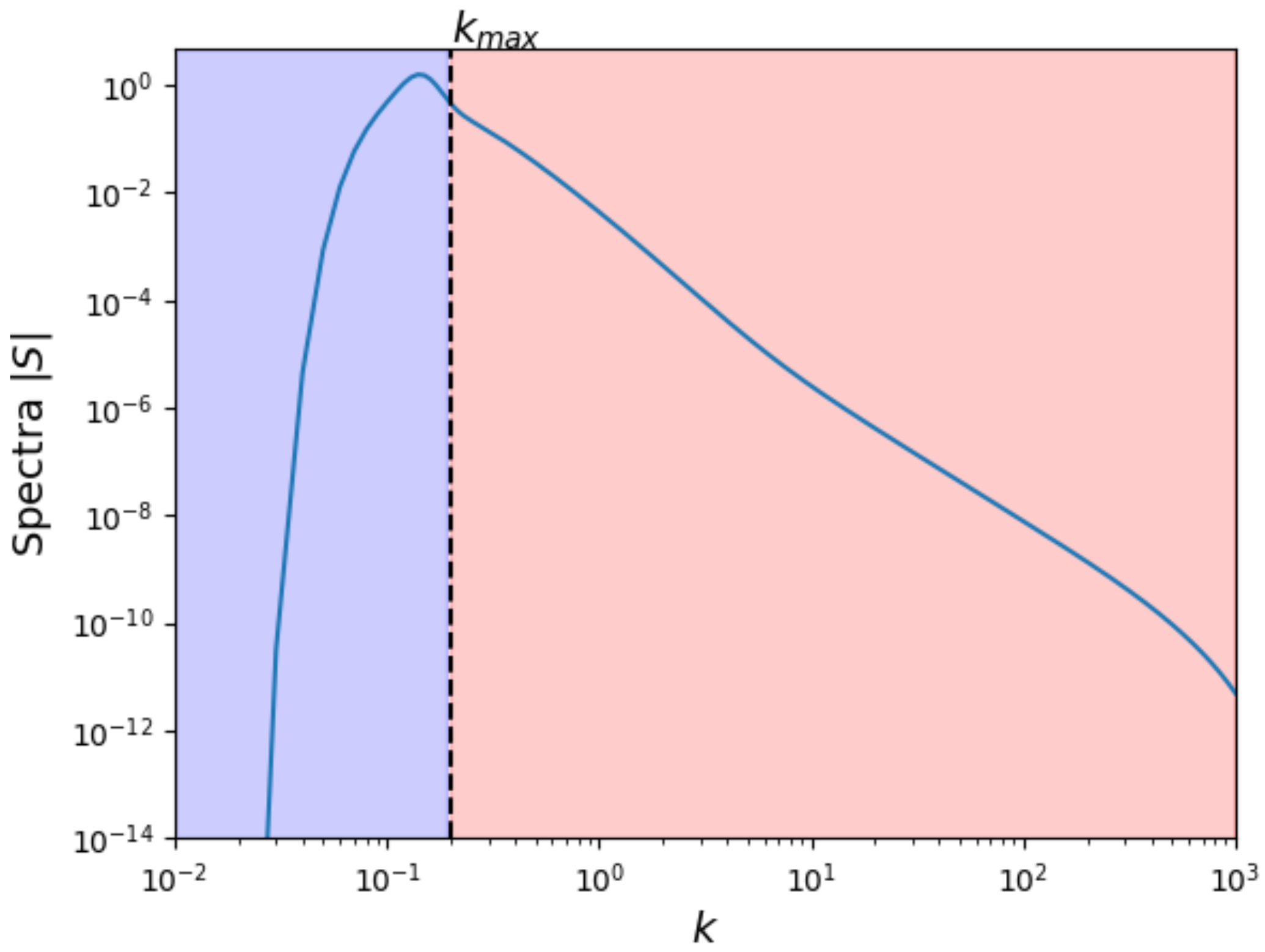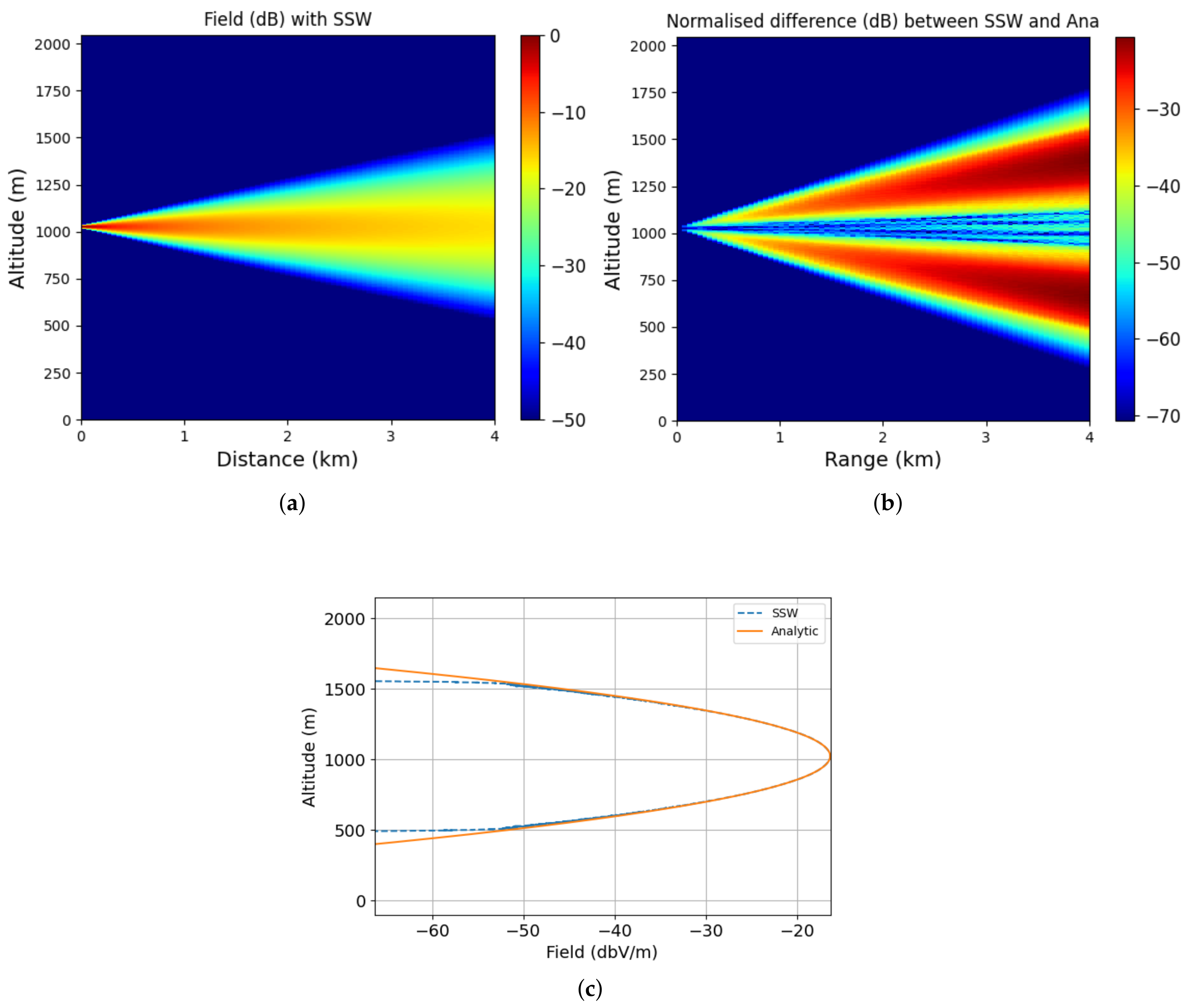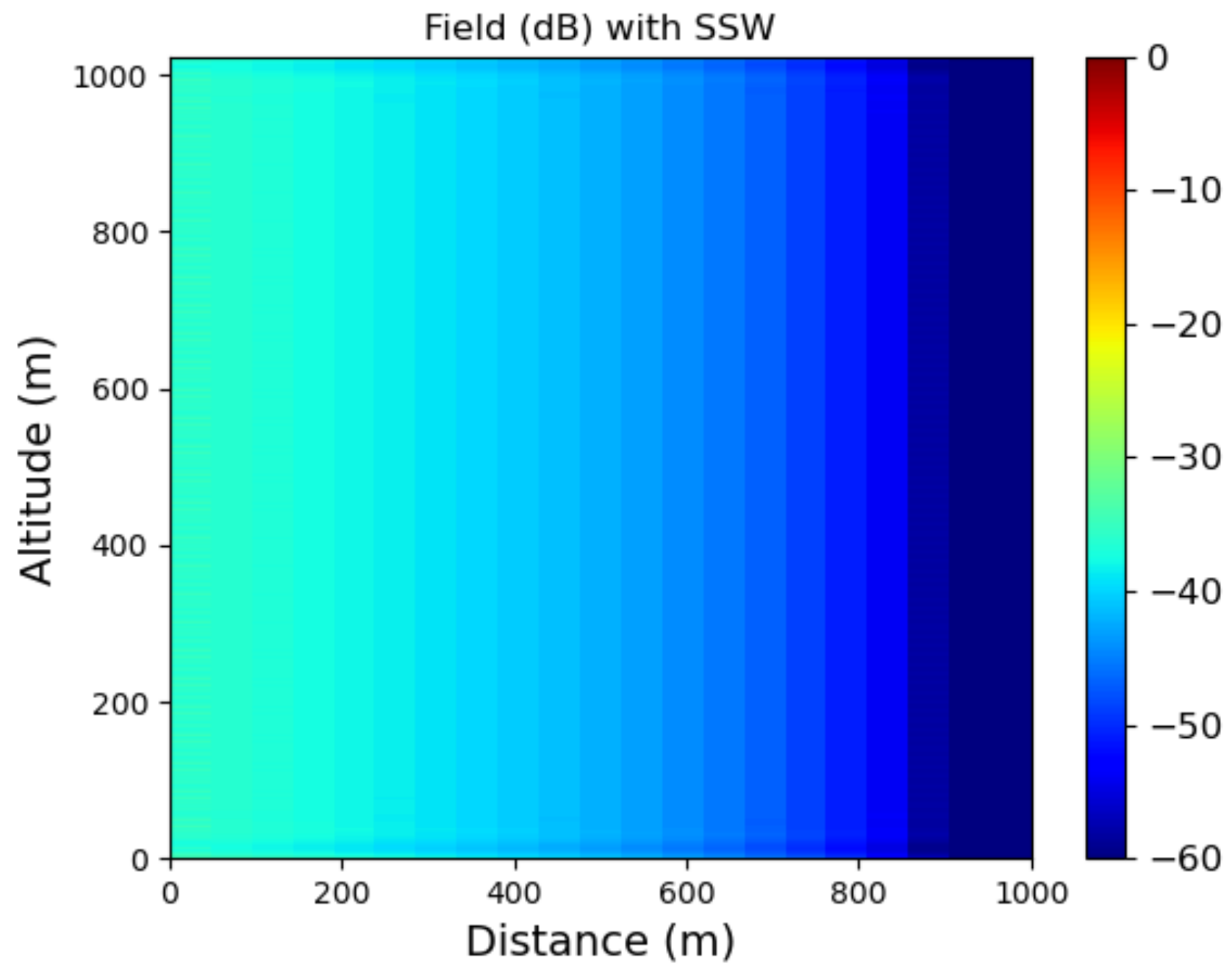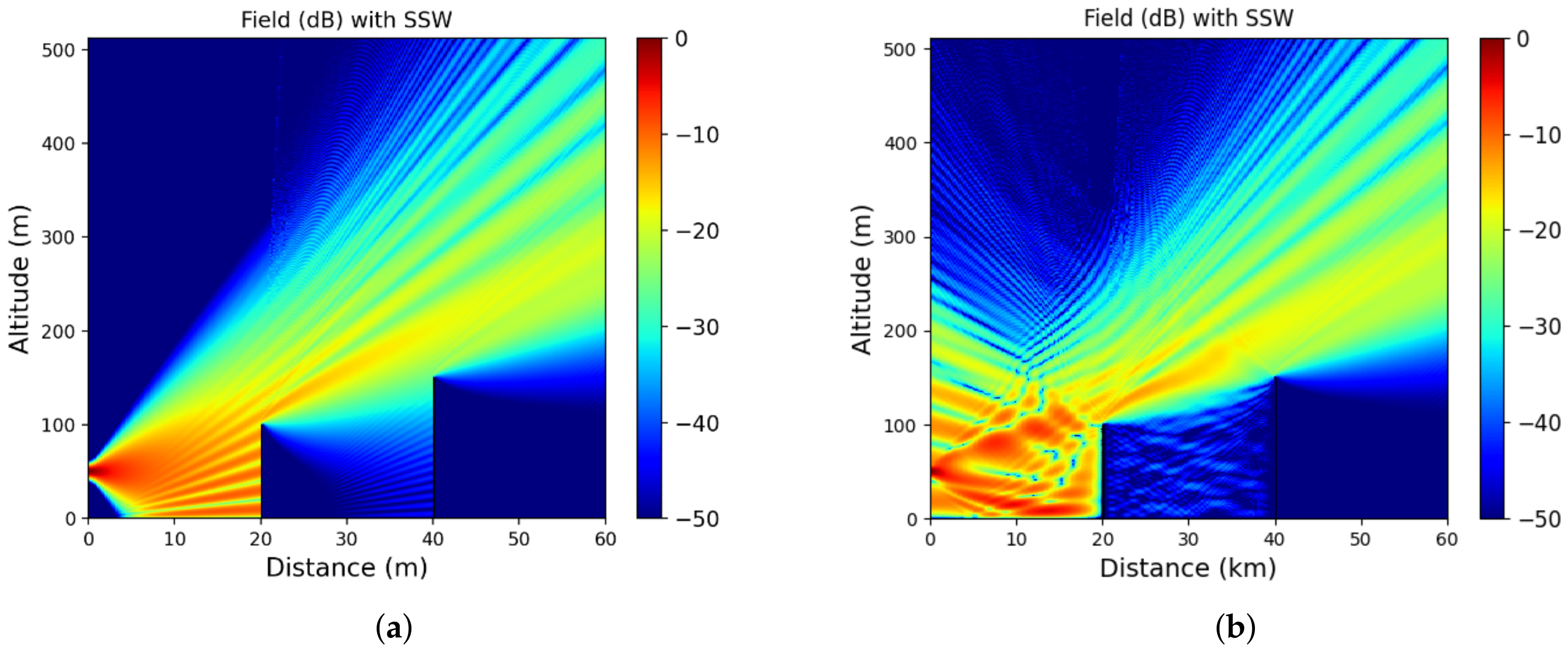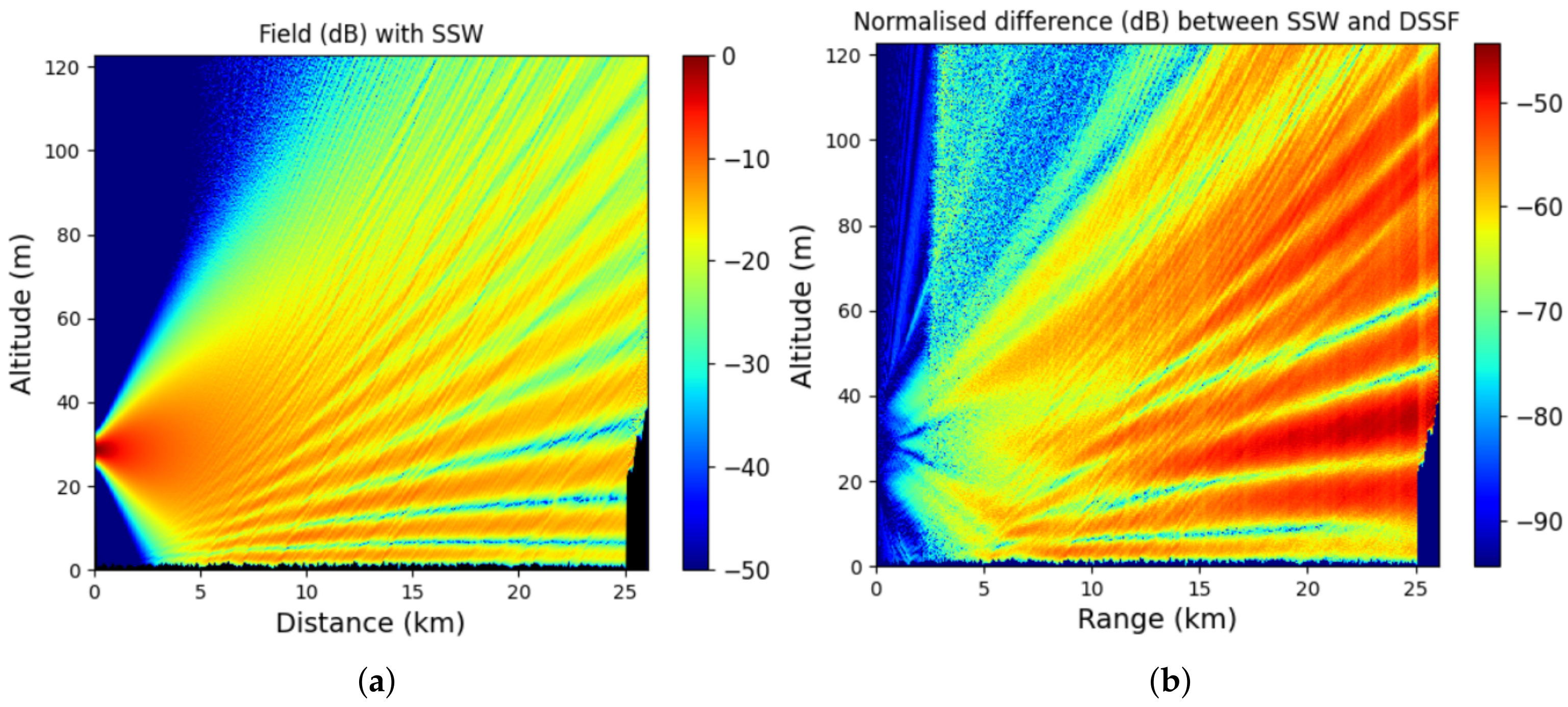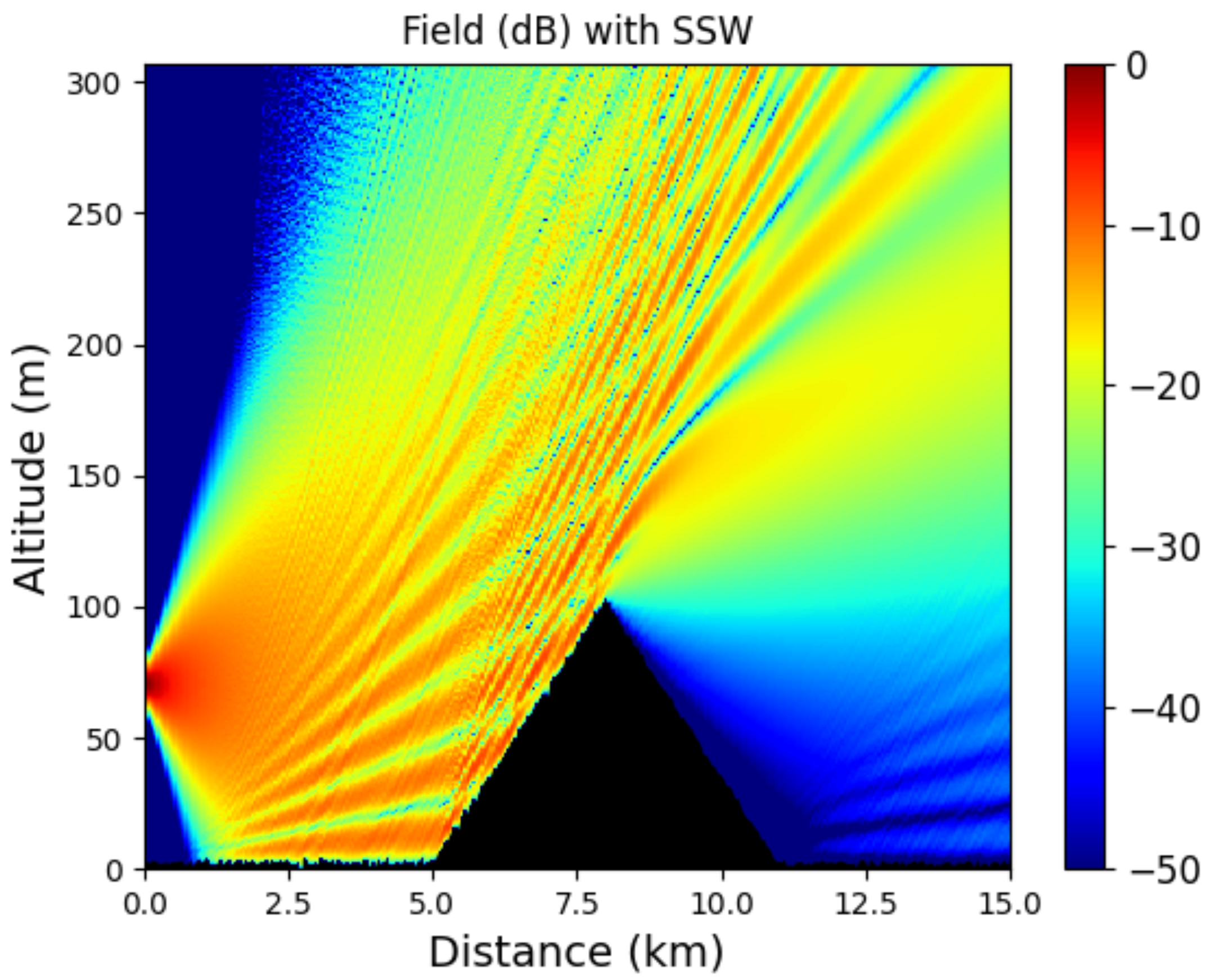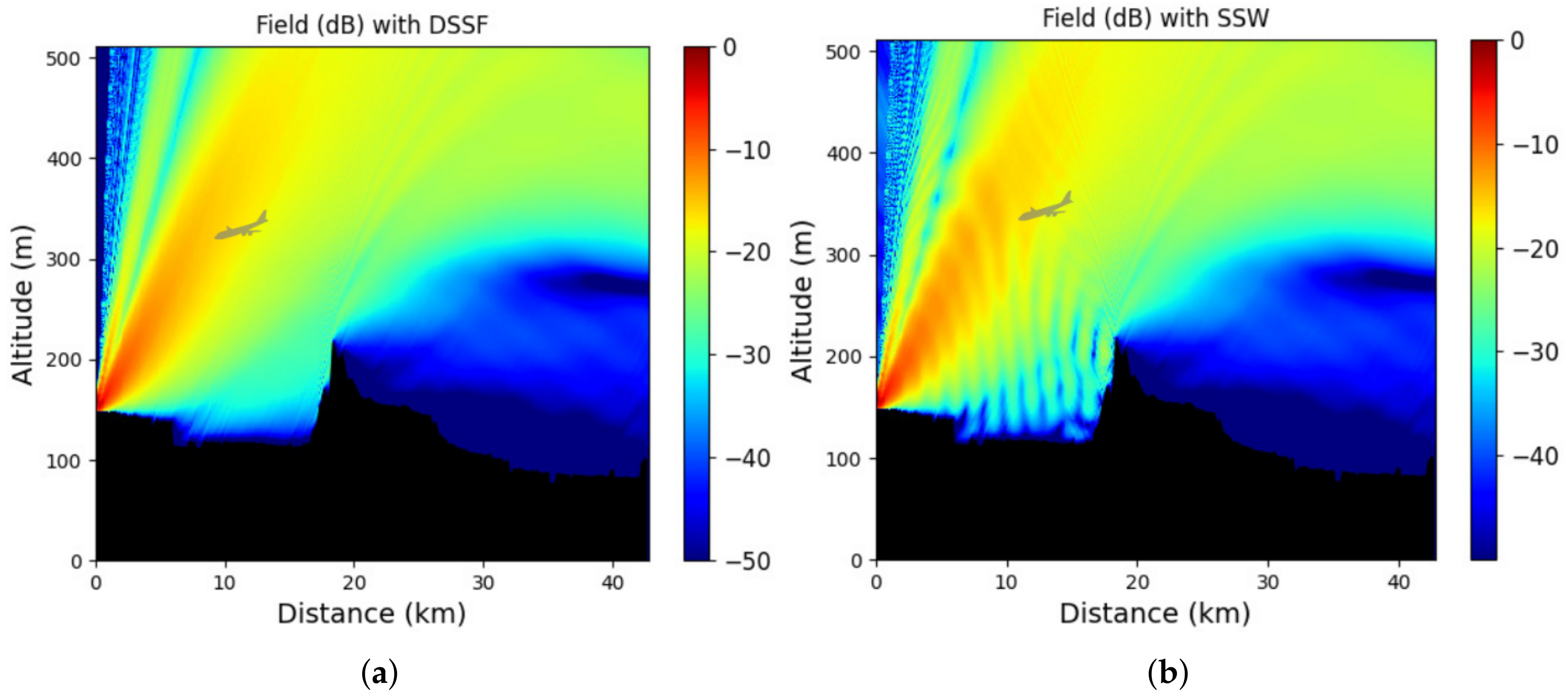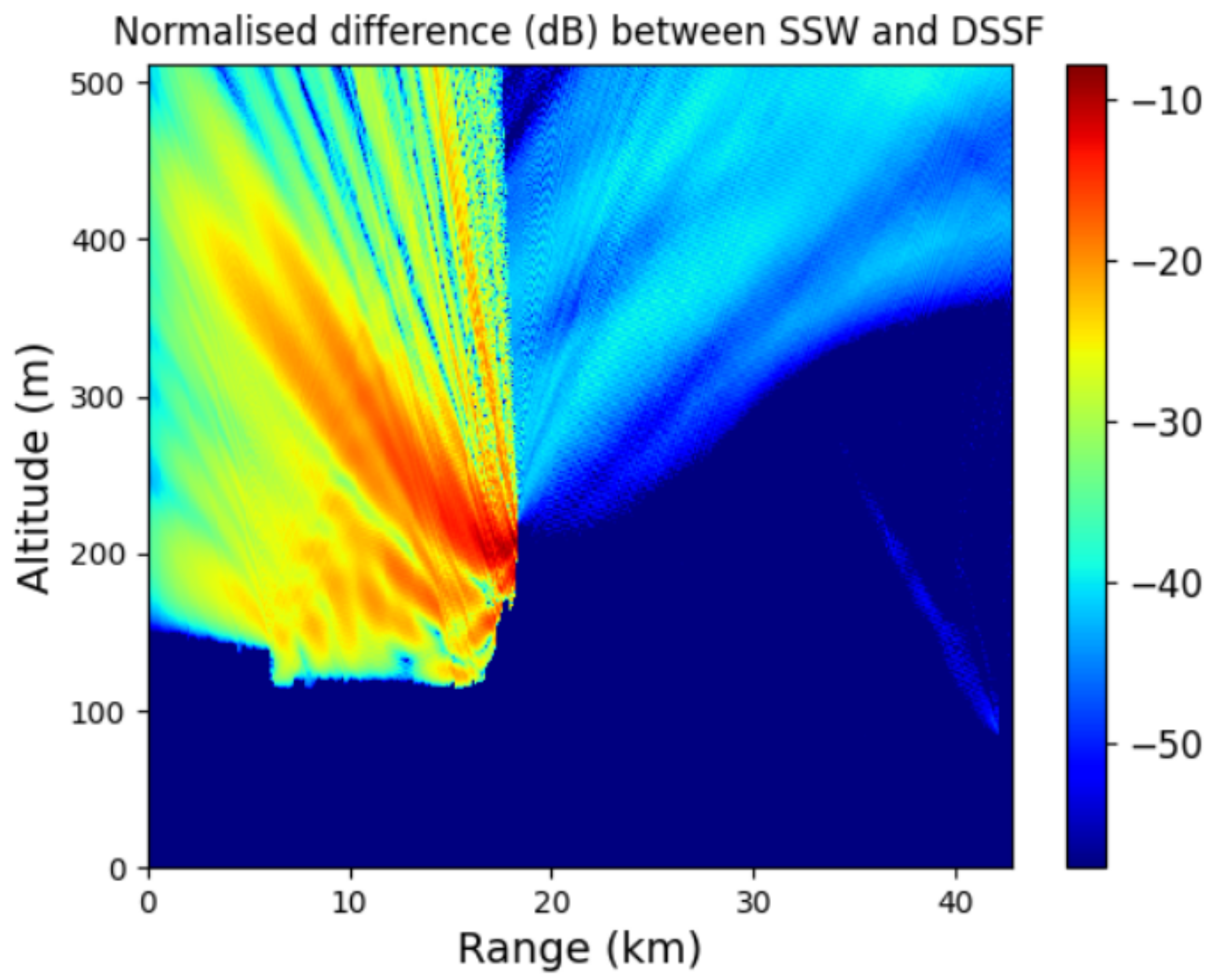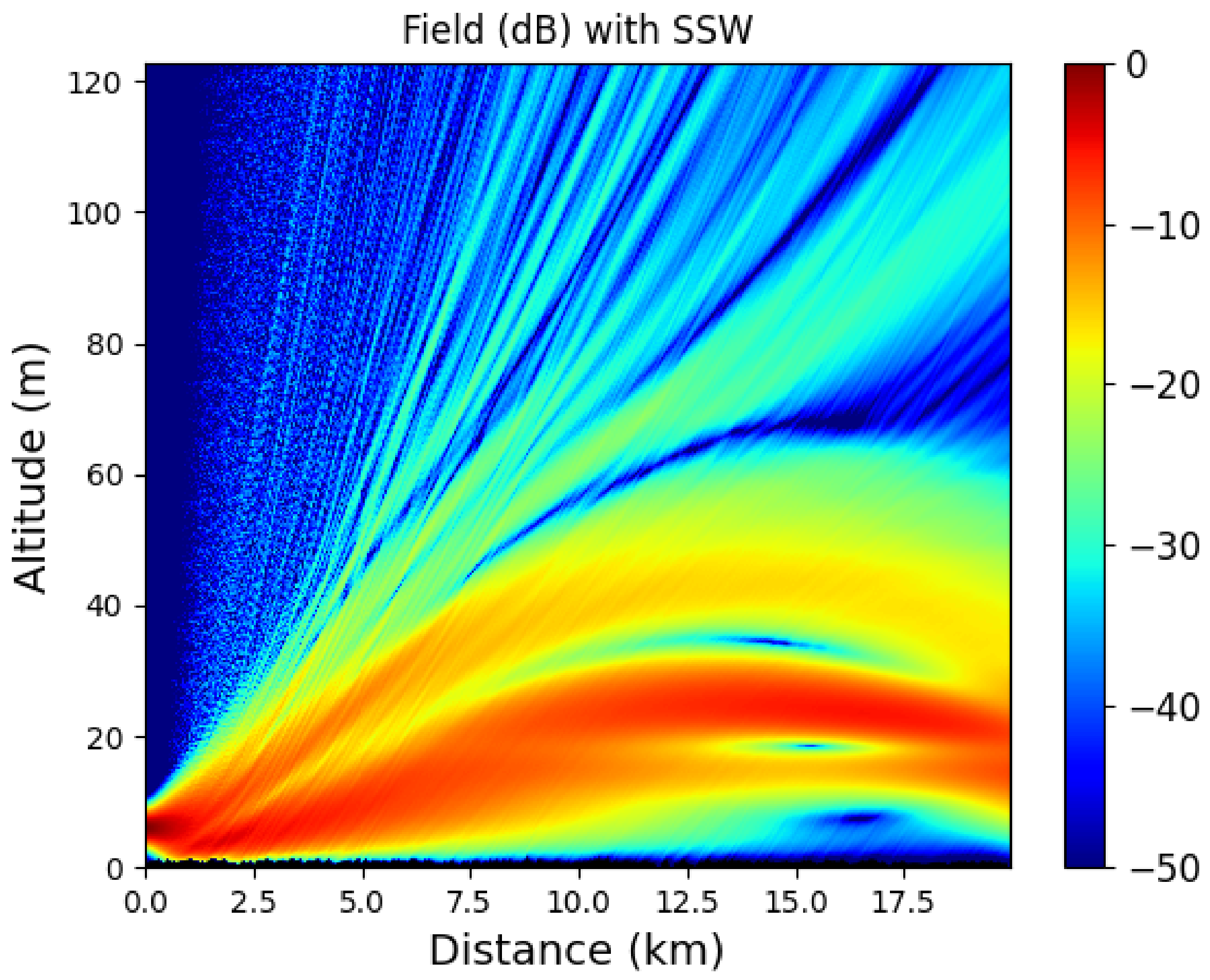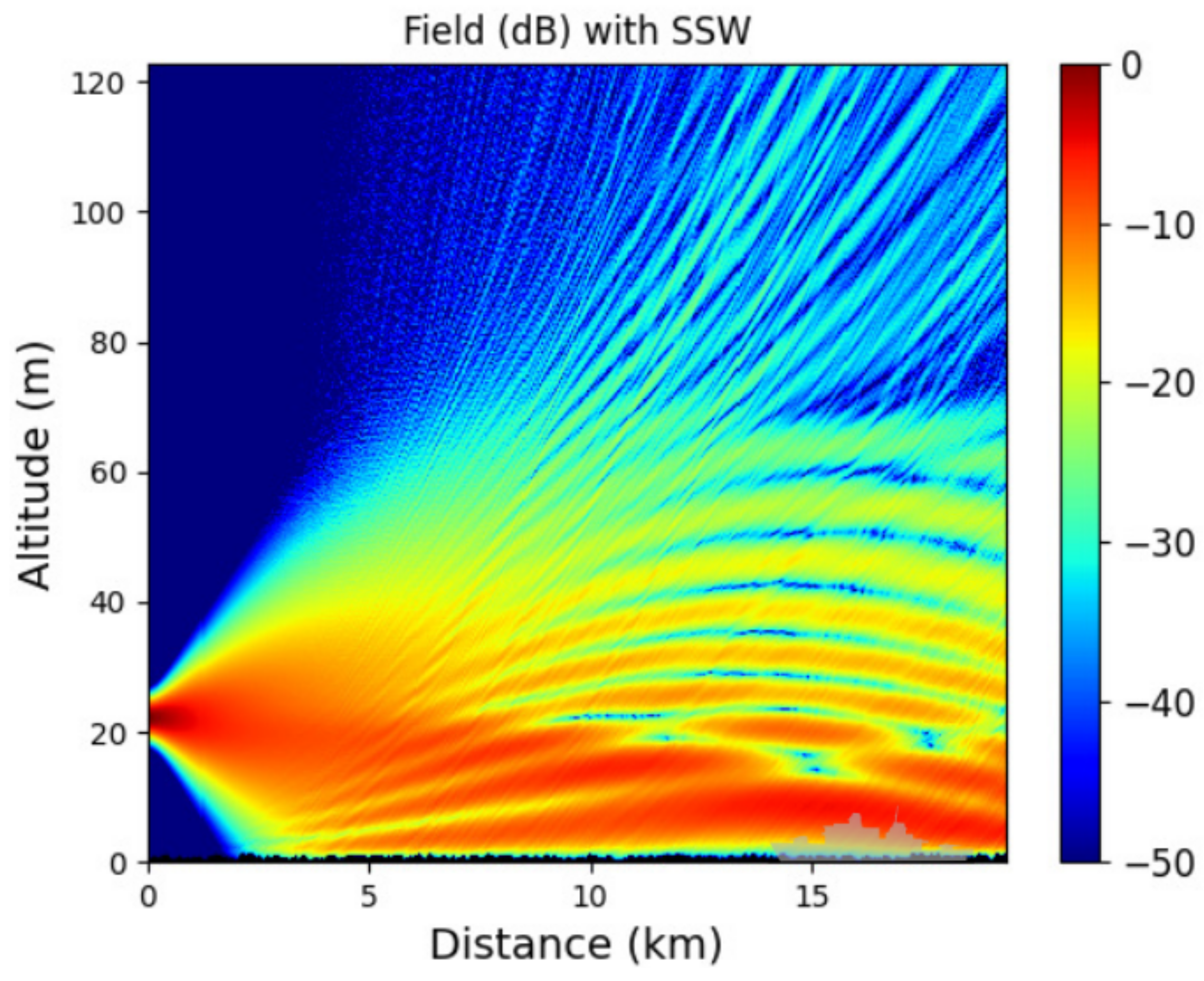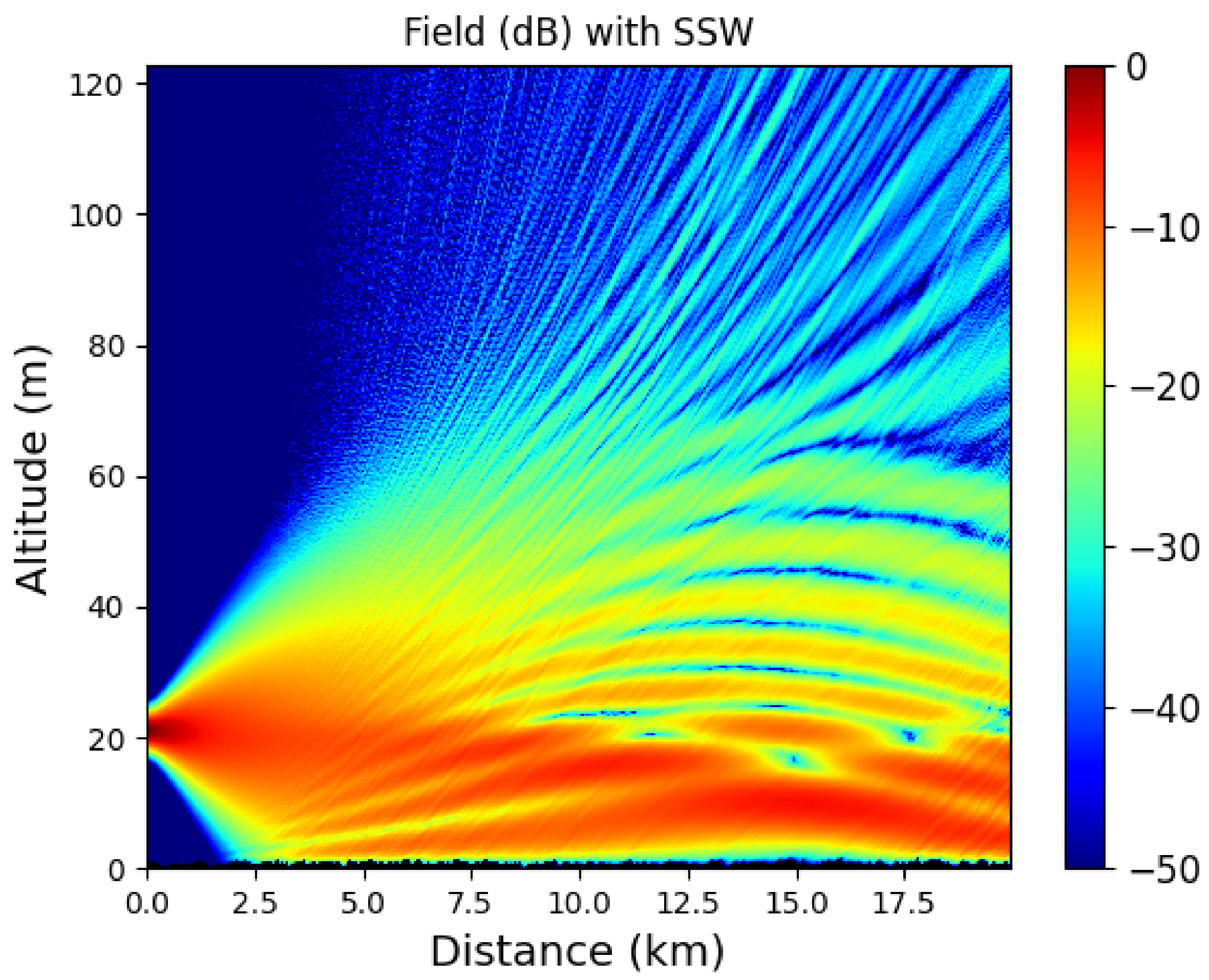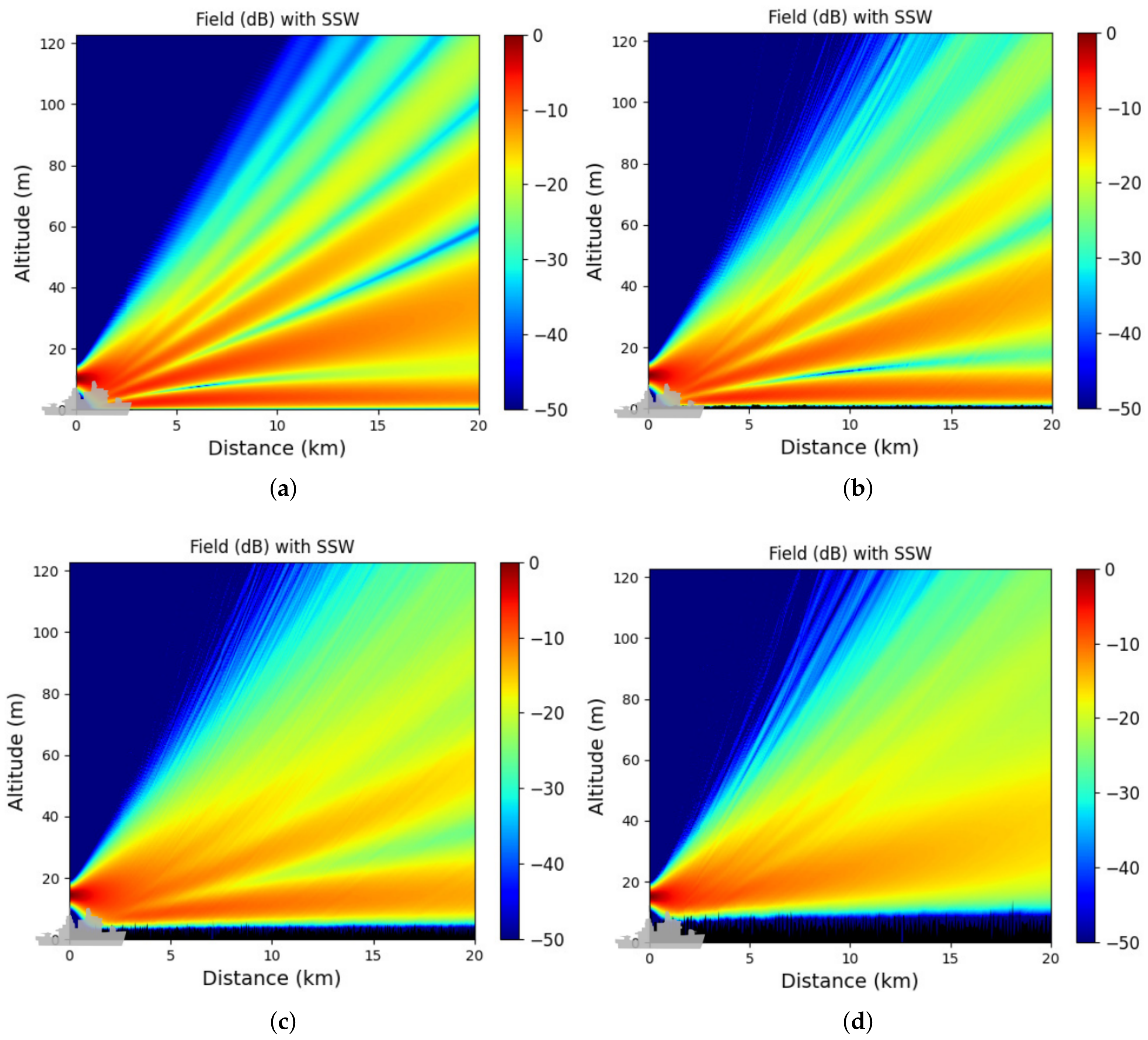1. Introduction
Accurate modeling of tropospheric long-range propagation is important for many applications in surveillance, communication, and remote sensing, for instance, the optimization of an antenna position based on the location conditions. This is also particularly important for predicting the coverage of new systems or the impact of man-made structures on the coverage of existing systems (e.g., the impact of solar panels or wind turbines on system performance) [
1]. Fast and accurate modeling of the electromagnetic wave propagation is also important for inverse problems such as refractivity from clutter (RFC) [
2,
3] or radio-occultation [
4,
5]. In this context, one must consider different interactions of electromagnetic waves with the propagation medium, such as relief, atmospheric ducts, or rough surfaces.
Due to the mesh-size limitation, rigorous methods are not suitable. Indeed, the discretization steps must be of the order
for methods such as the finite difference time domain [
6], the method of moments [
7], or the finite element [
8]. Assuch, we use an asymptotic method. Ray-based methods [
9] could be thought of, since they are accurate and model a wide range of physical phenomenon, such as the diffraction effects [
10], but in our case they are limited due to the caustic problem, the shadow area problem, or the number of rays needed to account for all the physical phenomenon [
11,
12]; whereas the relief is a limitation for the Gaussian beam method [
13,
14]. Thus, we use an asymptotic model based on the parabolic wave equation (PWE) [
15,
16,
17], which is adapted here, and commonly used in this context. As a matter of fact, the effects of the refraction, terrain, relief, and diffraction are considered in this model [
16,
17]. This latter is based on a simplification of the Helmholtz equation by only considering the forward propagation in a paraxial cone [
16,
17]. Therefore, no backward propagation is introduced in the model.
The two main computational schemes commonly used to solve the PWE are either a finite difference (FD) [
18] one or the split-step Fourier (SSF) method [
16,
17]. The latter is widely used in our context, since it allows wide steps in the propagation direction. Indeed, with the FD scheme, a mesh size of
[
17] is required, while, with SSF, the step size in the propagation direction is of order the
[
17]. In this scheme, the propagation is performed in two steps. First, the field is propagated through a layer of free space in the spectral domain. Second, the effects of refraction are considered in the spatial domain through a phase screen [
17]. The discrete mixed Fourier transform [
19,
20] allows us to take into account impedance ground conditions. The relief can also be considered with different methods [
17,
21,
22], such as the staircase model [
17]. To avoid spurious solutions, a self-consistent algorithm has been proposed [
23]. Furthermore, to overcome the problem of the backward propagation, a two-way SSF [
24,
25,
26] algorithm has been introduced, allowing us to precisely consider multiple reflections and multi-path effects.
Recently, a wavelet-based scheme has been developed in 2D [
27,
28,
29,
30] and 3D [
31,
32] to improve the memory efficiency of the method and to accelerate it to propagation. This latter follows the same steps as SSF, but the free-space propagation step is performed in the wavelet domain instead of the Fourier one. Indeed, the lower complexity of the fast wavelet transform (FWT) [
33] over the fast Fourier transform (FFT) and the compression performed on the wavelet coefficients allow us to obtain an efficient method [
29].
The objective of this article is to propose a fast, memory efficient, and reliable asymptotic model for 2D tropospheric electromagnetic wave propagation for a large band of frequencies that accounts for relief, ground composition and roughness, and refraction. The contributions are thus threefold. First, a two-way SSW scheme is proposed, which departs from the two-way SSF method [
25,
26], indeed the stopping criteria are shown to be intrinsic here. Second, the hybrid approach proposed in [
34] to take into account the ground roughness effects is introduced into SSW. Third, numerical tests are proposed to validate and test the method related to practical problems, such as a radar coverage or the optimization of an antenna location.
The remainder of this article is organized as follows.
Section 2 introduces the method. Firstly, the model and the discretization are explained. Secondly, a brief reminder of the 1D discrete wavelet transform is performed. Thirdly, an overview of the SSW scheme is provided. First, SSW is described for solving the one-way PWE. Second, the method is generalized for the two-way case. Third, the hybrid approach to consider the rough sea surface is introduced. Finally, a comparison between SSF and SSW in terms of the complexity and of the memory usage is proposed.
Section 3 is devoted to the numerical experiments in various conditions.
Section 4 concludes the paper and discusses the advantages and limitations of the proposed method. Finally, perspectives for future works are outlined.
3. Results
In this section, numerical simulations are performed. First, we validate the one-way and two-way SSW computational schemes. Second, a propagation test with knife-edge obstacles in the S-band is performed to compare the results to [
25,
26]. Next, the SSW scheme with the hybrid method is validated with two different scenarios: propagation in a maritime environment and propagation over snowy clutter. Finally, the method is applied on different problematic scenarios, such as the prediction of a radar coverage, optimization of an antenna location, and as the direct method in the RFC context. All these tests are performed at different frequency ranges.
3.1. Validation of SSW
In this section, we aim to validate one-way SSW by comparing the results to the exact solution for a complex source point (CSP) [
13].
Therefore, the propagation from a CSP at MHz is studied along the x axis. The computations are performed in a domain of size m and m. The steps are m and m along the x and z axes. The source is placed at m and m with a width of m. For comparison with the exact solution, we assume , and the domain has been defined such that the propagation can never reach the ground. The thresholds in SSW are set so as to obtain a maximum compression error of dB at the end.
The results are plotted in
Figure 3a–c. In the first image,
Figure 3a, we have plotted the propagation obtain with SSW.
Figure 3b shows the difference between SSW and the exact solution on the computational domain. The last,
Figure 3c, pictures the fields at the last iterations obtained with SSW and the exact solution.
In
Figure 3b, it can be seen that the error between the exact solution and SSW is below
dB, which is negligible, as expected. Moreover, the error is mainly outside a cone along the propagation direction, which is due to the paraxial approximation, the compression introduced in SSW, and also to the mesh size as mentioned in [
44]. Moreover, one can see in
Figure 3c that both fields are matching on the last iteration until
dB. Thus, the one-way SSW scheme works well.
Furthermore, in this case, the propagation for 80 iterations has been performed in 1 s, and the memory size of the propagator is of the order 1 kB, showing that the method is also efficient. Further studies have been carried out in [
28,
44] to validate the method; these show the effects of the different parameters.
In conclusion, the one-way SSW works well and is efficient in terms of both computation time and memory usage.
3.2. Validation of the Two-Way SSW
In this section, we validate the two-way SSW method. To do so, a plane wave at MHz (UHF-band) is propagated in the x direction until a PEC of the size of the computational domain is reached. We expect that the total field will be negligible.
For this scenario, the domain is of size
m and
m. The mesh size is
m along the
x-axis and
along the
z-axis. A PEC wall of 1024 m is placed at
. Until this obstacle, we propagate in free-space. Thus, an apodization window below and above the computational domain is used to avoid parasite reflections. In addition, to validate the two-way method, we assume
to only account for the propagation scheme. We plot the normalized total field in dB, sum of the incident and reflected fields, in
Figure 4.
As can be seen in
Figure 4, the total field is negligible in the propagation domain, as expected. Indeed, at the PEC wall, where the reflections begin, it is below
dB, while increasing to below
dB at the origin of the domain. Thus, the two-way version of SSW works well in a canonical test.
3.3. Propagation over Two Knife-Edge Obstacles
Now that two-way SSW has been validated, the method is used to compute the propagation over the ground, while considering two knife-edge obstacles, as in [
25,
26].
Here, the propagation from a complex source point [
13] in the S-band,
GHz, is studied. The source is placed at
m and
m with a width of
m. The computation domain is
[0, 60,000] ×
m
. The steps along both axes are
m and
m. To validate the method in this case, a PEC ground condition is considered, and we assume
. We also consider two knife-edge reliefs placed at
km and
km at altitude
m and
m, respectively. Here, the thresholds are set using the theoretical formula in [
37], such that a maximum error of
dB with SSF is obtained. Note that the thresholds also correspond to the implicit stopping criterion of SSW.
The normalized reduced field obtained with the two-way SSW method is plotted in
Figure 5b. The results for the one-way version of SSW are also picture in
Figure 5a in order to compare both results.
First, the error between the one-way SSW and SSF is below
dB, as expected. Second, with the one-way method, see
Figure 5a, only the forward propagation is computed. Thus, the reliefs induce only shadow areas and diffraction in the propagation direction. As can be seen in
Figure 5b, with the two-way algorithm, we also consider the reflections due to the relief. Therefore, the multi-path effect in between the relief is considered here, but the computation time is increased to account for all the backward propagations. Note that only the implicit stopping criterion has been used here, even if the multiple reflections between both obstacles are considered. Additionally, the results are in line with those obtained in [
26], showing that the method works well. Therefore, if we want to accurately compute the coverage of a given antenna while accounting for complicated structures, the two-way version is better. Nevertheless, if the computation is limited, for example in the RFC inversion problem, or if only the last iteration is needed, we can use the one-way version of SSW.
3.4. Propagation above the Sea
In this section, we validate the one-way SSW method with the hybrid approach for the propagation in a maritime environment. The results are thus compared to the ones obtain with SSF [
34,
41].
In this scenario, we model the propagation from the Saint-Mathieu Lighthouse (Plougourden in France) and the airport of Ouessant (France) at
GHz (X-band). The considered source is a CSP placed at
m, and its width is
m. The relief between the source and ending points is obtained through the data provided by the “Institut Nationale de l’Informations Géographique et Forestière” (IGN) [
45]. Thus, the islands between both places are also considered, such as the island of Molène.
The computational domain is of size [0, 26,000] × [0, 123] m
. The mesh sizes are
m and
m along the
x and
z axes, respectively. For the different ground conditions, we consider the parameters of a dry ground (
and
S/m), for the terrain, and of the water (
and
S/m), for the sea surface. We generate the sea surface geometry using the hybrid approach described in
Section 4. A wind speed of
m/s is considered. We also consider an evaporation duct at the sea surface [
46]. The wavelet parameters remain the same for this test.
The results are plotted in
Figure 6.
Figure 6a shows the propagation of the reduced field u computed with SSW. In
Figure 6b, we show the normalized difference between SSW and SSF along the propagation.
First, in
Figure 6, one can see that we account for both the effects of the refraction and of the sea surface geometry. Indeed, the electromagnetic waves are straight-lined near the sea, in the surface duct. In addition, one can also note the effects of the surface geometry with the diffractive pattern in the propagation. Second, the error is below
dB. Thus, the SSW with the hybrid approach is validated in this case. Furthermore, the results are in line with those obtained in [
34,
41]. Finally, only one simulation has been performed here. Since the sea surface generation is random, a Monte-Carlo approach should be considered and is performed in
Section 3.7 and
Section 3.8.
To conclude, we note that using this approach allows us to model more precisely the effects of the sea. This is of high importance for the RFC inverse problem [
2,
3], where an accurate and fast forward model is needed. This latter is studied in
Section 3.8 for various sea conditions. This is also of serious concern for the prediction of radar coverage and optimization of antenna location near the sea, as will be seen in
Section 3.7.
3.5. Two-Way Propagation in Snowy Condition
In this section, we test the SSW method while considering snowy ground conditions [
41].
In this scenario, we study the propagation from a CSP in the UHF-band (
MHz) over a snowy ground. The snow dielectric parameters are taken from [
47], so as to compute the reflection coefficient for the local image method. Therefore, we have
and
S/m. The hybrid method is used to take into account both the snow surface and the attenuation. A triangular relief is also considered.
The source of the parameters remain the same, except that the source altitude is m. Finally, the computations are performed in the following domain: [0, 15,000] m. The mesh sizes along x and z are m and m. The propagation is computed both with the one-way and two-way SSW methods. For the two-way method, to avoid unnecessary computations, backward computations are only computed for reliefs of more than m in altitude. Finally, the wavelet parameters remain the same.
The results are plotted in
Figure 7 and
Figure 8, for the propagation computed with one-way and two-way SSW, respectively. The normalized reduced field on the overall domain is shown.
First, one can note the interest of using the hybrid approach. Indeed, the effect of the roughness of the snow clutter can be seen as an interference pattern due to the relief introduced by the snow surface. Second, for both methods, as expected, the results beside the triangular relief are the same. Nevertheless, in front of the relief, the two-way method allows us to consider the reflection toward the source. Thus, we have obtained an accurate propagation method in various environments.
3.6. Application to the Prediction of Radar Coverage
In this numerical experiment, the two-way SSW method is applied to predict the coverage of the Toulouse airport radar (France) in one direction.
To do so, we model the antenna propagation pattern as a CSP [
13] in the VHF band (at
MHz). The parameters of the source are as follows:
m,
m and
m. The 2D propagation between the Toulouse airport and Montauban is modeled here with the two-way SSW method and the SSF scheme in order to compare them. The relief between the two places is taken into account using IGN data [
45]. To account for a realistic effect, a tropospheric duct modeled with a tri-linear profile of refraction [
46] is accounted for. The parameters for
M are
M-units,
m, and
m, and the gradients are
M-units/m and
M-units/m; see
Figure 9 for a presentation of the parameters.
This latter models a tropospheric duct as a three layers refractive index that varies linearly in each layer with a different gradient. Thus, corresponds to the altitude until the first change of gradient from , positive, to , negative, and to the transition altitude, with the altitude of the second change of gradient from to .
The computational domain is of size m and m and sampled with steps m and m. We consider a dielectric ground condition of parameters and S/m, which correspond to the conditions of a dry ground. Finally, the wavelet parameters remain the same.
For this scenario, we first plot in
Figure 10a,b the field computed with the one-way and two-way schemes, respectively. Second, the normalized difference between both schemes is pictured in
Figure 11.
Figure 10 shows the differences in the prediction of the radar coverage between the one-way and two-way methods. Indeed, in between both reliefs the two-way SSW scheme takes into account the backward propagation. Thus, an interference pattern appears, but no shadowy areas above
m appear due to the multiple reflections, which is very important in the context of radar coverage. Therefore, a landing plane, such as the gray one, is spotted by the radar. Otherwise, after
km, one can see that both methods give the same result. Moreover, the difference between both methods is small, as can bee seen in
Figure 11. Thus, even with the reflections, an airplane can be spotted.
Note that, as pictured in
Figure 11, the difference between both schemes is localized in between the relief, as expected, and is of order
dB, which is small. Moreover, the error after the second relief is due to the compression introduce in SSW. Therefore, the choice between the two-way and one-way schemes to predict radar coverage mostly depends on the environment. If more reliefs, such as metallic structures, are considered, then reflections are important and should be considered even if the computation time increases.
Nevertheless, this scenario shows that the method works well and is useful to compute radar coverage in given conditions.
3.7. Application to the Optimization of an Antenna Location
We now study the propagation in a maritime environment, as in [
34,
41]. In particular, we apply the SSW method with the hybrid approach for the sea to optimize the antenna location for given conditions.
For the following tests, the propagation is studied in the X-band with GHz. The source is placed in the harbor of Toulon (France). Thus, the propagation is modeled above the Mediterranean sea until km from the source. The propagation domain is, thus, of size m and m. The considered source is a CSP placed at m with a width of m. The altitude of the source above the ground will vary along the numerical tests and is the parameter to be optimized here. The goal is to obtain the best possible coverage. The steps are as follows: m and m.
The sea dielectric parameters are
and
S/m [
47]. Sea surfaces and the attenuation parameters are computed through the hybrid approach using the Elfouhaily spectrum. We consider a wind speed of
m/s. Since the surface generation is random, 50 Monte-Carlo simulations are performed.
We also consider a tropospheric duct above the sea, modeled with a tri-linear atmospheric index [
46]. The parameters are as follows:
M-units,
m, and
m, and the gradients are
M-units/m and
M-units/m. The wavelet parameters remain the same.
We first consider an antenna located
m above the ground. In this case, the predicted coverage is plotted in
Figure 12 and
Figure 13. In these figures, we plot the mean of the sum of the 50 reduced fields obtained through the Monte-Carlo simulations and the worst-case scenario in terms of ship detection, respectively.
From the results pictured in
Figure 12 and
Figure 13, we can conclude there is a shadowy area at
km where ships would not be spotted, as pictured with a gray ship that can not be seen. Thus, the coverage of this antenna needs to be improved. In order to do so, we change the antenna location to
m above the ground.
As before, we plot in
Figure 14 the mean of the sum of the field obtained through 50 Monte-Carlo simulations with the SSW scheme. As before, we also plot the worst-case scenario in
Figure 15 to verify that a ship will still be detected.
The first conclusion from
Figure 14 is that, by changing the antenna location, shadowy areas are no longer seen around the sea, even in the worst case scenario, see
Figure 15. Therefore, any ship, such as the gray one, can be spotted in this case. Nevertheless, in this case, the propagation is more stuck in the tropospheric duct, and less energy exists above
m. This is not a problem in our context (ship detection).
This scenario shows that the method is also useful for the optimization of an antenna’s location. Obviously more tests in different conditions should be performed to conclude on the final antenna position. Furthermore, if the antenna altitude can be changed, this method allows us to find a good position given the location conditions.
3.8. Forward Model for the RFC Problem
In this last numerical test, we study the propagation above the sea from the antenna of a ship, which corresponds to the forward model of RFC [
2,
3]. The main objective is to show that the surface geometry must be taken into account in this context. Thus, different conditions of wind to generate the sea surface are studied. Moreover, in the RFC scenario, the goal is to have a fast forward model, thus we use the one-way SSW scheme.
Here, the propagation above the sea from a CSP at
GHz (in line with the frequency used in RFC [
48]) is modeled. The sea surface is generated through the hybrid approach of
Section 2.3 for different wind speeds
m/s.
For all wind conditions, the following parameters are the same. The source is located at m and m above the ground (on the top of the ship). Its width is m. The computational domain is of size m × m. The discretization is performed with steps m and m. We consider an impedance ground condition of parameters and S/m that corresponds to the parameters of water. We also consider a surface duct of m. The wavelet parameters are the same as in the previous tests. Finally, for each wind speed, 50 Monte-Carlo simulations are performed.
In
Figure 16a–d, we plot the means of the propagated field over all Monte-Carlo simulations for the different wind speeds
m/s, respectively.
Figure 16 shows the effects of different sea surfaces geometry on the propagation of electromagnetic waves. Indeed, for different wind speeds the sea waves are stronger, thus the propagation is affected. As can be seen, the radiation lobes throughout the propagation are different between the four figures (a) through (b). As a matter of fact, the more the wind speed increases, the fewer lobes are presents, but the first lobe becomes larger. As can be seen in
Figure 16d, we only have one lobe for a high wind speed. In the RFC scenario [
2,
3], we measure the field at the last iteration in order to retrieve the refractive index. Thus, if the sea geometry is not accounted for, one can see that error would be introduced in the forward model.
4. Discussion
Characterizing the propagation canal is very important for many applications, such as radar, teledetection, or communications. In this context, one needs to model the long-range propagation in the troposphere while accounting for the relief and the ground composition and roughness. Thus, fast, accurate, and memory-efficient computational methods are needed. To improve the accuracy of the existing SSW method, we have introduced here a two-way version of SSW in order to consider back-propagations. Furthermore, a hybrid approach to consider rough surfaces has been introduced to SSW. In addition, this method is better both in terms of memory efficiency and computation time than the usual SSF method.
First, the two-way PWE has been introduced. This allows us to take into account both the forward and backward propagations, while the usual PWE only considers the forward part. Second, the SSW scheme is introduced to solve the two-way PWE. We show that no explicit stopping criterion is needed, since the compression introduced in the wavelet decomposition works as an implicit stopping criterion. A complete comparison between SSF and SSW in terms of time and memory efficiency is proposed. This shows that, with good compression, SSW is better than SSF in both parameters. Finally, numerical experiments are performed. They allow us to validate the method and show that two-way SSW works well in various conditions (relief, sea, snow) and at various frequencies (UHF-band, S-band, X-band). Applications of the method in different scenarios, such as the optimization of an antenna location or the prediction of radar coverage, are also proposed.
We have thus shown that the newly developed two-way SSW is efficient for modeling the tropospheric long-range propagation in various environments and useful for different applications. Indeed, the low complexity of the wavelet transform and the compression introduced in SSW allow us to obtain an accurate and a memory- and time-efficient numerical scheme. Additionally, using the wavelet properties, the stopping criterion for backward propagation is implicit and can be changed throughout the propagation, departing from the two-way SSF. This adds versatility to the method. Furthermore, ground conditions and roughness are considered with this scheme, with no cost on the computation time.
Nevertheless, this method has limitations. First, the complexity and memory usage rely mostly on the compression. Thus, if the signal we are dealing with is not smooth, then the computation time increase. In addition, taking into account the backward propagations with the two-way SSW scheme increases the computation time. Thus, given the scenario and the accuracy needed, a choice between the one-way or two-way computational method must be performed. Secondly, the method solves the wide-angle PWE, and the results are valid in a cone of around . Third, the reliefs considered are limited in slope, since the method is (for now) only developed for the staircase model. More reliable models of terrain are under study, but this induces a change in the wavelet-to-wavelet propagator and in the initial condition for the two-way SSW method. Finally, some physical phenomena are not considered, such as the diffusion or complex interaction of the electromagnetic waves with the sea waves.
Further works include more numerical tests. This could also lead to a basis of numerous computed propagations for different inputs (ground condition, sea surface geometry, refraction, etc.), which could be useful for inverse-problem or artificial intelligence-based propagation schemes [
49]. We are also investigating how to efficiently parallelize the two-way version of SSW. Furthermore, other applications of this method should be studied, such as the ionospheric propagation with SSW [
50]. We are also investigating a hybridization of SSW with a wavelet-based method of moments (MoM) [
51], similar to SSF with the MoM [
52], for a better accuracy when dealing with relief and man-made structures. To conclude, the generalization of the approach to 3D [
31,
32] would be an evolution of the proposed work.
